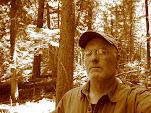It is a gray day, for sure. But unlike all too many recent days, there is little wind and it would be a shame to not make use of the conditions.
I set from under the highway bridge on the far side of town, not wanting to submit myself to the mad-dash-looming-holiday drivers. It is about 35F with a 5 to 7 mph west wind. Without a speck of sunlight, that light wind brings on a chill to any bare skin, although not to any bear skin. The tide is still going out, but it does not have long to go to reach bottom.
It's an easy paddle down to the marsh, and I am warmed up by the time I get there. There are few route choices at this low tide level. All of my favorite shortcuts and inner channels are empty of water and will be so for a few hours. I head up Beaver Brook, flush a dozen Black Ducks near the first northward bend, and decide at that point to leave the rest of the brook to the Ducks. It is a preferred hiding spot in the winter. On the way back I spook a Great Blue Heron as it comes in low over the marsh to land at the edge of the water. The Heron circles back and disappears.
I head down as far as Cat Island. The main channel becomes mud flat at that point, as expected. Spot a flock of 15 Dunlin and a Killdeer, and 3 more Great Blue Herons. The Herons are probably here as inland waters freezes over.
I hear several shotgun blasts as I head over to Nell's Channel. I have a pretty good idea of where the hunters are, down where the tall spartina thins out and opens up into mudflat, or open water at high tide.
Rather than extend the trip towards the hunters, I opt to call it a day. Spot a single Dunlin that does not seem the least bit scared of me. On the way up river, I spot a Harrier up higher than normal. It uses a couple of S-turns to drop to the marsh without gaining speed and begins a hunt by skimming the marsh.




















































